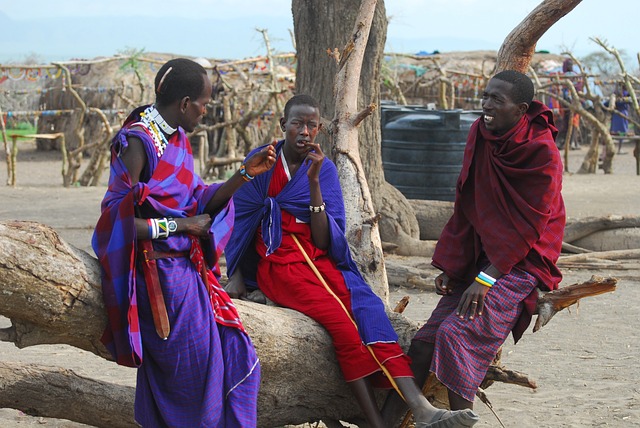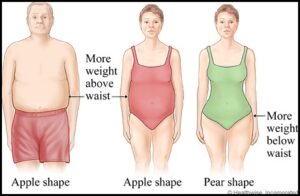There are three evolution-based theories about why obesity is now so common throughout the world. It is nearly impossible to say which, if any, of these theories is correct. It could be a combination of two of them. I will discuss all of the theories in this blog and let you choose which one you like the best.
Most people know the effects of obesity on disease rates and health, so I will not talk about that. Also, people know that excess caloric consumption usually leads to weight gain. But why can some people eat all they want without gaining a pound, while other people eat like birds and do a ton of cardio but cannot lose a pound? Obviously, weight gain has a genetic component; otherwise, anyone who ate too much would be obese. I am nowhere near obese, but I used to run 40 minutes a day five times per week and lift weights, but I never managed to lose any weight. My diet was low in calories and based on whole foods as well.
Humans have two types of fat tissue: brown adipose and white adipose tissue. We have mostly white adipose tissue. White adipose tissue specializes in energy storage. Brown adipose tissue specializes in using calories (mostly from fat and sugar) to keep us warm. Brown adipose tissue actually increases our metabolism and helps us burn calories when it is activated. Activating it is the hard part.
There are three dominant theories about the effects of selective pressure on energy storage. In the thrifty genotype hypothesis, the selective pressure is periods of famine, which would promote energy storage. In the drifty genotype hypothesis, the selective pressure was predators, which selected for leanness in individuals so they could outrun these animals. The last theory does not have a name, but selective pressure is the external temperature, hot or cold. All three theories have their pros and cons. All likely have some elements of truth. They are all interesting, and none can be completely written off. I tend to favor the new theory because it has the fewest holes in its theory. I will talk longest about the newer theory because it is the one most based in science and the one that has the most potential to combat the current obesity epidemic.
The thrifty genotype hypothesis
Storing calories was probably advantageous throughout many cultures over the past tens of thousands of years. Many groups of people had harsh winters with little food, so they ate a lot beforehand, kind of like bears do before hibernating. Those who remained lean and could not store enough fat may have starved to death. This may be why the majority of people today have such an issue with storing extra fat, while so few people can eat all they want without gaining much weight. In scarce times, storing excess calories is life-saving, but in times of feast, storing excess calories is harmful. The main issue with this theory is that it cannot account for the very different obesity rates seen between different ethnic groups. It assumes all people have the same genetic capability to store excess calories, which is not the case. Despite this, this theory can still be partly true.
The drifty genotype hypothesis
This theory is based on the idea that, at one point, our human ancestors had to be lean, fast, and agile to hunt and avoid predators. Because of this pressure, the genes of lean individuals were passed on, while genes that promoted obesity were selected against since many of these people would have died before having many children to pass their genes on to. Once humans formed groups and used stone weapons, they were able to become the top predators. At this point, both lean and obese humans would have similar survival rates, and the obesity genes would no longer be selected against. Because of this, they would have remained in the gene pool and passed on the same way the genes for leanness were.
An interesting theory is that predation dictates the upper limits of fat gain. In Africa, for example, if someone became too heavy, they would be unable to outrun a predator (the slowest person in the hunting party would likely get taken). So although it would be physically possible for these people to become obese, those who stored little fat would likely be selected, and those who stored too much fat may have had a shorter life span and fewer children. This may explain why Pacific Islanders have such high rates of obesity: they have no natural predators and were able to gain as much weight as they wanted without any significant impact on their reproduction (1).
The newest theory about the evolution of fat storage—the new kid on the block
Overview
Within the past few years, a completely new theory about the biological evolution of obesity has emerged. This theory makes a lot of sense, and I hope there will be more studies based around it, as I feel it can one day offer treatment for obese individuals. This theory looks at the vastly different obesity rates among different ethnic groups as proof that it is not as simple as saying every ethnic group has evolved genes for storing excess fat in cases of starvation. This theory revolves around the fact that once humans left Africa and spread around the globe, they would all have experienced different selective pressures in regards to fat storage, heat and cold adaptations, famine, and disease susceptibility (2). This theory does not rule out the possibility that when the first humans left Africa, they all had genes that favored energy storage, but they do argue that after a long period of time, once humans spread out, they evolved different physiological reactions to excess feeding selected by the environment they were living in.
Recent human evolution
While the thrifty genotype theory argues that humans have not evolved much in the past 10,000 years, genetic analysis has shown that natural selection has caused an extremely large number of genetic changes in the past 10,000–15,000 years, many of which are relevant to health and disease (2). Examples of recent genetic variations that have evolved specific to geographic location include people in malaria-ridden areas having genes that offer resistance (at the expense of developing sickle cell anemia), genes that allow digestion of lactose (90% of Chinese are lactose intolerant while 14% of Caucasians are), and genetic protection from HIV infection (2). Knowing this, it is not outside of the realm of possibility that different ethnic groups have experienced mutations in a few genes or changes in metabolic processes that affected energy storage.
Different rates of obesity by ethnic group
Obesity affects about 30% of the American population (2). The following is a list of the percentage of obese individuals by ethnic groups living in the United States: Pacific Islanders: 45%; Native Americans: 40%; Black Americans: 39%; Hispanics: 32%; Caucasians: 26%; and lastly, East Asians: 11% (2). These are huge differences in obesity rates. Can it all be explained by different dietary habits? Partly, yes, but genetics also plays a huge role.
Selective pressures: genetic variations in obesity susceptibility
So, I keep talking about selective pressure but have yet to define it. The selective pressure this theory is based on is climate. Different climates of different ethnic groups forced selective pressures based on that type of climate. They argue that the ability to regulate your body heat efficiently in the cold and keep your body heat low in hot weather were powerful advantages that were selected for in their respective environments. If we are unable to make it through childhood, what advantage would selective pressures for fertility have? Therefore, the innate ability to survive in specific climates would be favored and selected for during evolution.
Enter brown adipose tissue, or BAT. As opposed to white adipose tissue, BAT helps maintain body temperature in cold climates. This is the dominant type of tissue found in bears while hibernating and in newborn humans. This type of tissue generates heat and uses energy (3). Would this type of tissue be selected for humans living in frigid climates? Perhaps if it meant the difference between life or death and clothing was not adequate enough to survive in those climates. Brown adipose tissue is full of mitochondria (cells responsible for creating energy), which give this tissue its red or tan color. Very low temperatures act as a stimulus, which activates the heat generation caused by BAT. Because BAT requires energy, it can use additional sources of energy from calories or fat, which would promote leanness and use energy from the diet instead of storing it. Which ethnic groups hail from these frigid climates? East Asians, Siberians, and people in parts of Europe—the same countries that have the current lowest rates of obesity (2). People from the arctic typically have higher metabolic rates than people from warmer climates (2).
On the other end, genes that prevent overheating, stroke, and dehydration would be selected for by people inhabiting tropical climates like Africans, Indians, Central Americans, and Southeast Asians (2). Africans today have lower body temperatures, reduced metabolic rates, and dark pigmentation (protecting from UV damage), all traits that are tailored towards hot climates and detrimental to very cold climates. In these people, evolution would have selected against those with BAT, as this would cause overheating and likely death in infancy. Therefore, these people would have had high amounts of white adipose tissue and low amounts of BAT. Basal metabolic rates are highest in arctic people, intermediate in white Europeans, and lowest in Africans (2). Even among white Europeans, those who have lived in extremely cold environments have lower rates of obesity than other European areas.
Native Americans are most closely related to Asians, particularly Japanese and ancient Siberians, who have evolved in a cold environment, so why such high obesity rates for Native Americans? East Asians and Siberians have higher metabolic rates and much lower rates of obesity than their Native American cousins. When Native Americans first crossed the Bering Straight into Alaska and migrated south along the western coast of the United States, they were met with land covered in ice. Around 13,000 years ago, they moved into the hot climates of Arizona and Mexico. Evidence suggests that through time, these peoples began to lose their adaptations for the cold while reacquiring adaptations for living in hot climates (2).
An interesting side note… Pima Indians have the highest rates of heart disease in the world. This is likely due to a greater capacity for salt retention, which leads to high blood pressure, which leads to heart disease. The interesting part is that salt retention is believed to be an adaptation to the heat because, in the heat, we sweat a lot, and sweat contains salt, so we run the risk of losing enough salt to cause dangerously low salt levels in our body. In this case, an adaptation to retain more salt makes perfect sense, but it is disastrous with the current high-salt American diet. This adaptation lends support to the idea that Native Americans may have also acquired other adaptations to the heat, such as lower metabolic rates and lower body temperatures, hence leading to their high obesity rates today (in addition to a high caloric diet, of course). It was also found that Native Americans have the same amount of gene mutations for improved heat adaptation as that seen in Africans, showing that 20,000 years (the amount of time since the Native Americans crossed over into America) is enough time for genes to mutate and become the dominant gene of the population.
Activating BAT
Thermogenesis refers to producing heat; BAT produces heat by burning calories.
What activates BAT to increase thermogenesis? Change in outside temperatures and photoperiod length (physiological response to the length of a day or night). Studies exposing humans to cold show significantly elevated energy expenditure, likely due to BAT activation and its effect on thermogenesis (2). The researchers believe that the artificial warming of all houses in the United States may prevent activation of BAT, which can lead to weight gain even in those with significant amounts of BAT because the stimulus of cold exposure is removed (2). As opposed to the thrifty genotype hypothesis, this hypothesis is that those who have evolved in the cold with high levels of BAT would actually have a hard time getting their body to store fat, resulting in leanness despite a high-calorie diet (the BAT would use the calories to warm the body, not store them for later use).
Obesity reduces fertility.
To my surprise, none of the theories mentioned that being obese may have been selected against during human evolution since obesity is associated with reduced fertility. Reduced fertility means fewer children and fewer genes passed on to the next generation. Obesity in women has been associated with negative changes in embryonic development that may prevent or stop pregnancy even after in vitro fertilization (4). BMI (body mass index) is a measurement to assess if someone is overweight or obese based on their height and weight. Women with a BMI of 35 (obese; <25 is normal weight) are 26% less likely to achieve spontaneous pregnancy than normal BMI women, while women with a BMI of 40 or more are 43% less likely to get pregnant. Male obesity is associated with reduced sperm quality, an alteration in the physical and molecular structure of germ cells in the testes, and mature sperm, all of which reduce the chance of impregnating someone (4).
Future directions
BAT Thermogenesis Theory (there was no name for the theory, so I picked this)
How will finding the evolutionary cause of energy storage and obesity help us with the current obesity epidemic? In the BAT theory, if we were somehow able to stimulate the BAT of people, we could greatly increase their thermogenesis. Lowering the ambient temperature may activate BAT, but who would want to sit around their house shivering? There is also research on drugs that may stimulate receptors on BAT and research trying to make white adipose tissue mirror some of the qualities of BAT. In addition, there is testing to use stem cells to stimulate the growth of brown adipocytes, which may be a chance to give BAT to people with little to no BAT. Similar to other strategies using stem cells, doctors could inject stem cells into obese patients, which would become BAT.
Even if there is a genetic predisposition to obesity, the environment cannot be discounted. Like diabetes or heart disease, a genetic susceptibility to something does not guarantee you will develop it; the genes first have to be activated through diet. If you are prone to obesity but consume low calories and exercise or weight train, you may never become obese. If you are resistant to obesity but are sedentary and eat 5,000 kcal a day, you can become obese. My point is that, whether susceptible or not susceptible to obesity, the environment is powerful enough to override either.
There is a lot more research out there about BAT in humans and how many calories its activation actually burns. It is a new and exciting field with huge implications for obesity. I will make a blog in the future just about the BAT/cold theory and another blog talking about obesity studies using identical twins raised in different homes. Until then!
Sources





Interesting post….I read that stadistics say average “city people” eat from 1-2 times outside home in a week. It contributes a lot to weight gaining in modern life.
If not more! I used to think it was simple as eating too many calories = gaining weight but this blog made me rethink that idea. Ultimately excess calories do cause weight gain in most BUT how effecient your metabolism is at burning excessive calories determines if you gain weight. So metabolism is very important in determining how many calories you can consume before gaining weight. I will definitely talk more about brown adipose tissue and weight gain in the future. This theory is really exciting!
It is so interesting reading about the different theories and how your genes play a big role on obesity. But I think is more on your diet and physical activity. I can’t wait to read your blog on the BAT/cold theory.